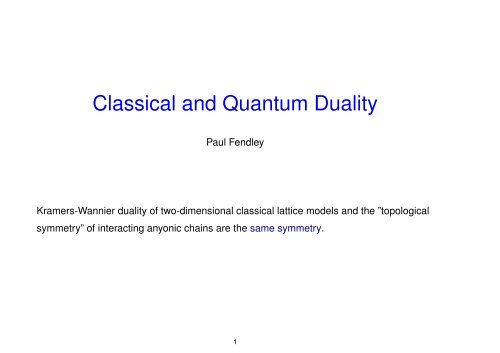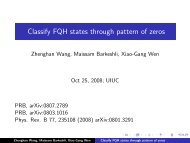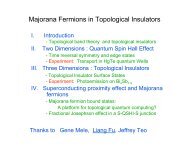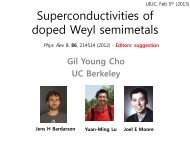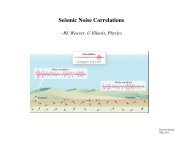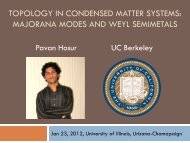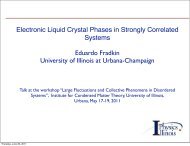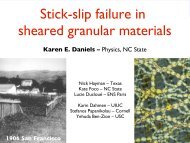Paul Fendley
Paul Fendley
Paul Fendley
- No tags were found...
You also want an ePaper? Increase the reach of your titles
YUMPU automatically turns print PDFs into web optimized ePapers that Google loves.
What is Kramers-Wannier duality?The classical Q-state Potts model has a spin σ i = 1..Q at each site i of a lattice. Theenergy is simplyE = −J ∑ δ σi σ jso the partition function isZ L (K) = ∑ {σ i }e KP δ σ i σ j .where K ≡ J/T and L indicates the lattice the spins live on.Lots of interesting structure in this model: critical point in 2d for Q ≤ 4; Temperley-Liebalgebra; Tutte polynomial,. . .3
Perhaps the most remarkable thing about the Potts model is its (Kramers-Wannier)duality.Duality is the very non-obvious statement that with appropriate boundary conditions,Z L (K) = ZbL ( ˜K)where ̂L is the dual lattice to L, while K and the dual coupling ˜K are related by(e K − 1)(eeK − 1) = Q .The self-dual point is at K = K c , where (e K c− 1) = √ Q. In general, the dualitymaps between a model in the “high-temperature” phase K < K c and one in the“low-temperature” (ordered) phase K > K c .4
In terms of domain walls, the weight for a link separating spins σ i = a, σ j = b is(1 − δ ab ) + e K δ ab .a b a aIn the dual model, the analogous weight is(1 − δ αβ ) + eeK δ αβααβαwhere µ i = α and µ j = β are the values of the spins in the dual model.5
Build up the transfer matrix by taking products of these, for both horizontal and verticallinks. Think in terms of the domain walls, so each link is a two-state system: either thedomain wall is there, or it isn’t.Using (e K − 1)(eeK − 1) = Q relates the couplings for each state of the two-statesystem and the dual two-state system⎛ ⎞ ⎛ ⎞ ⎛⎝ e eK⎠ ∝ ⎝ 1 Q − 1 ⎠ ⎝ eK1 1 −1 1⎞⎠Everything can be generalized to non-integer Q by using the Temperley-Lieb algebra;note that (1 − δ ab ) and δ ab are (orthogonal) projectors. Then the TL parameter d (theweight of each closed loop) obeys d = √ Q.6
Topological aficionados note: this “duality matrix” changing the two bases is precisely theSU(2) k four-anyon fusion matrix for √ Q = 2 cos(π/(k + 2)) !Moreover, the standard pictures even look similar:= F 11= F01+ F+F 0010So what does duality have to do with non-abelian anyons?7
Duality = topological symmetryTopological symmetry is by construction a symmetry of interacting anyonic chains.Feiguin, Trebst, Ludwig, Troyer, Kitaev, Wang and Freedman8
The degrees of freedom in an interacting anyon chain are the fusion channels.For Ising fusion rules σ × σ = I + ψ;anyons are specified by the picture (unlabeled links are σ)σ × ψ = σ; the fusion channels of 2Nanyon 1 anyon 2c 2Nc 2 c 4 . . .anyon 2Nc 2NThis is an Ising Hilbert space! Each c 2i can be either I or ψ, while each c 2i−1 = σ.Thus we have an Ising chain with σ i = +1 when c 2i = I, while σ i = −1 correspondsto c 2i = ψ.9
The Hamiltonian of an interacting anyonic chain is then defined by demanding that itcommute with “adding a loop”.The Potts F matrix acts as❅❅ c ′ 2i= ∑ c F c 2i ′ c 2ic 2iwhere as before all unlabeled line segments are σ.By particular combination of F matrix moves, one can convert the process of adding aloop into an operation on the Hilbert spaceLevin and Wen; California stars10
The topological symmetry is easiest to see in the classical model. The Potts transfermatrix acts on a Q N -dimensional space of spins, the same Hilbert space as the 1dquantum Hamiltonian:T i−1 isssi−1siIn this picture, the domain walls are either horizontal or vertical lines connecting the siteson the dual lattice. The dual sites correspond to c 2i−1 = σ channels on the chain. Formore general models, need to have varying degrees of freedom here.11
The F matrix in the lattice model acts as:µi−1/2µi+1/2ForFsis iThe arrow indicates that F or ̂F can be thought of as changing the value of the spin atthe bottom of the arrow to the value at the top, depending on the values of the other twospins.For Ising,⎛ ⎞F = √ 1 ⎝ 1 1 ⎠ ,2 1 −1̂F = (−1)δ si µ i+1/212
The topological symmetry generator in the classical lattice model is then simplyµ µ µi−3/2 i−1/2 i+1/2FFF F F FFFsi−1sisi+1Note that the the non-trivial states shift; they are now on the dual lattice!13
To prove that this is a symmetry, it needs to “commute” with the transfer matrix. Moreprecisely, when commuted, it needs to give the dual transfer matrix:µ µi−1/2FFTi+1/2=µi−1/2µFTFi+1/2s is iIntegrability aficionados will recognize this as the Yang-Baxter equation. Up to (important)phases which cancel in the YBE, F is the limit of T with infinite spectral parameter.14
This construction enables one to generalize duality to many critical integrable models.Integrable lattice models are known which in the continuum limit yield all CFTsG k × G lG k+lIn fact, there can be even more than one duality for a given CFT. For example, for eachminimal CFT, there is both a Potts duality (what the California stars study) and a tricriticalPotts duality.Once you have the duality, there is no need to demand integrability: you can e.g. studyhow perturbations and operators in the lattice model and the CFT behave under theduality.15
This duality is also useful when studying 2d quantum nets.Quantum self-duality allows the construction of a simple(r) Hamiltonian annihilating atopologically-ordered ground state consisting of a sum over nets.For the square lattice, it requires only four-spin interactions.16
To build a quantum loop/net model,1. find a 2d classical loop model where loops are critical but local degrees of freedomare not (e.g. percolation)2. use each loop configuration as a basis element of the quantum Hilbert space3. find a Hamiltonian whose ground state a sum over loop configurations with theappropriate weighting, so that4. if you “cut” a loop, you end up with two deconfined anyonic excitationsKitaev; Moessner and Sondhi; Freedman17
The quantum Potts model uses the 2d classical Potts model for its underlying degrees offreedom.The domain wall on each link forms a two-state quantum system, i.e. the presence of thedomain wall is one state |1〉, while the absence is the orthogonal state |0〉.a b a a18
Each domain-wall configuration is a net: by construction, it has no ends.1233323322The Hilbert space of the quantum model for N links is still fully 2 N -dimensional.Configurations with “net ends” are by construction anyonic excited states.19
The weight of each net |N〉 in the ground state |Ψ〉 of the quantum model is found fromthe classical model:<strong>Fendley</strong> and Fradkin〈N|Ψ〉 = (Q − 1) −L NχbN (Q)χbN(Q) is the number of spin configurations allowed for each domain-wall configurationN . χbN(Q) is called the chromatic polynomial, and depends only on the topology of N .Its definition can be extended to all Q, not just integers.L N is the “length” of each net, the number of |1〉 states. This factor is put there to ensurethat...20
The quantum Potts model is quantum self-dual.This means we can equivalently define the model in terms of dual domain walls, |̂0〉, |̂1〉.= F 11= F01+ F+F 0010F =⎛⎝ 〈̂0|0〉〈̂1|0〉⎞ ⎛⎞〈̂0|1〉⎠ = √ 1 ⎝ 1 √ Q − 1√ ⎠〈̂1|1〉 Q Q − 1 −121
The weight of each dual net |D〉 in the ground state is( ) LD1〈D|Ψ〉 = √ Q − 1χbD (Q)This is the same ground state |Ψ〉 in a new basis!This quantum self-duality is highly non-obvious, and extremely useful.22
A Hamiltonian H with |Ψ〉 a ground state can be found simply by demanding that Hannihilate all states which are not nets and annihilate all states which are not dual nets.For the square lattice:H = ∑ +[P 1 P 0 P 0 P 0 + rotations]+ ∑ □[Pb1 P b0 P b0 P b0 + rotations]where P i projects onto the states |i〉, and Pbi = F P iF .23
ConclusionsIt has long been known that integrability and topological order are related: integrablemodels yield essentially all the known knot polynomials. Now we see that even old-schoolKramers-Wannier duality has a topological interpretation.Thinking about topology leads to a natural extension of self-duality to two-dimensionalquantum systems.This in turn leads to a much simpler Hamiltonian annihilating topologically-orderedground states.24


